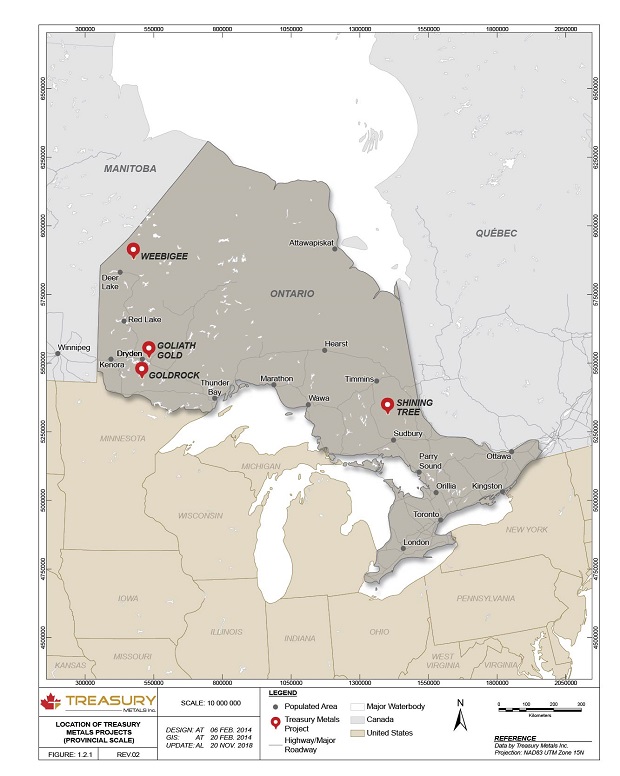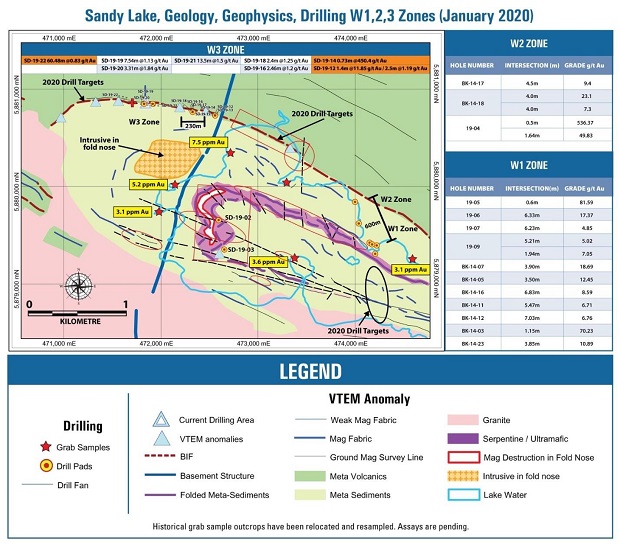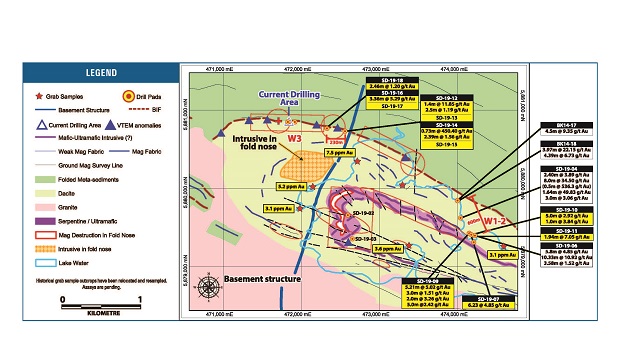Treasury Resources - Goliath Project
Weebigee

100% owned by Goldeye Explorations Ltd., a wholly owned subsidiary of Treasury Metals Inc.
Location
Goldeye’s Weebigee Project is located 227 kilometres north of Red Lake in Northwestern Ontario. The project is adjacent to Sandy Lake First Nation (population approx. 3000) which has excellent infrastructure including an airport with daily direct flights to Winnipeg, Red Lake and Sioux Lookout and winter road connection to Red Lake. All weather access roads are located within one kilometre of the Knoll, Bernadette and RvG4 areas. The NW Arm claim block hosts the highest density of gold showings in the Sandy Lake Greenstone Belt.
Description
Weebigee is a large, relatively unexplored property which covers the most prospective portions of the Sandy Lake Greenstone belt, with similarities to the geology of several mines (Red Lake, Madsen and Starratt-Olsen) in the Red Lake District. In the Northwest Arm area, numerous gold showings occur within shoreline exposures of quartz-rich felsic pyroclastic units, proximal to a major deformation zone. Where strained, the felsic units show biotite-silica or chlorite-fuchsite alteration, quartz veining and patchy silica flooding, along with the development of distinct blue quartz eyes. It should be noted that much of the geology is obscured by shallow lakes and clay deposits, and the 2,219 m drill program completed in 2014 is the first significant drilling at Weebigee, followed by the Optionee’s 2019 drill program.
In the past, shoreline mapping and prospecting located a number of auriferous quartz tourmaline veins and silicified zones controlled by mafic-ultramafic dyke filled splays or high strain zones crosscutting regional foliations. Crack and seal textures, drag folded and dismembered veins, multi-stage quartz veining and local strong silica replacement zones indicate that hydrothermal alteration occurred during periods of active brittle- ductile deformation along the high strain zones. Geophysics indicates that a folded ultramafic horizon is located just offshore of several of these auriferous high strain zones.
Option Agreement
On April 15, 2015 Goldeye entered into a Weebigee Project option agreement with GPM Metals (Since the date of the original 2015 Option Agreement, GPM’s property interests were acquired by Sandy Lake Gold Inc. as per Sandy Lake Gold press release on July 21, 2016, and Sandy Lake Gold Inc. has since been renamed G2 Goldfields Inc. (“G2” or the “Optionee” in April 2019).
A brief summary of the Option is, as follows:
1: Grant of 50.1% Option
In order for this Option to be in good standing and for the Optionee to exercise the 50.1% Option, the Optionee (G2 Goldfields Inc.) must take all actions and do all things necessary and complete the following on or before the relevant date and as outlined in the Option Agreement:
- Make payment of $50,000 in cash and issue such number of Common Shares (the “Consideration Shares”) to Goldeye as shall have an aggregate fair market value of Cdn$25,000, following receipt of all necessary approvals, (based on the volume weighted average price of such Consideration Shares over the next five business days;
- Make three additional cash payments on or prior to certain dates over three years, of an aggregate total of $500,000 to Goldeye; and
- Complete expenditures on the Project of a minimum aggregate total of $5,000,000 upon certain dates over 4 years.
2: Grant of 70% Option
To acquire a further 19.9% interest in the Property (for an aggregate 70% interest in the Property, the Optionee, must have taken all actions and done all things necessary and exercised the 50.1% Option and subject to the Option Agreement’s subsection 10.5(b), after having exercised the 50.1% Option, must, at its election, either:
- Deliver a feasibility study to Goldeye on or prior to the date which is five years following the date upon which the Optionee exercises the 50.1% Option; or,
- Make cash payments to Goldeye and complete exploration expenditures on the Project as follows:
- Three cash payments to Goldeye of an aggregate total of $1,500,000 in the Agreement’s specified timeline over 2 years;
- Complete expenditures on the Project of $1,000,000 on or prior to the first anniversary of the 70% Option notice date; and, complete additional expenditures on the Project of $2,000,000 on or prior to the 2nd anniversary of the 70% Option notice date.
The Agreement is subject to the terms of the SLFN Exploration Agreement between Goldeye and Sandy Lake First Nation, and which recognizes the importance of opportunities for Sandy Lake First Nation to secure benefits as the Weebigee Project progresses and the importance of the SLFN Traditional Territory to the people of SLFN. Through the Agreement, the Optionee and Goldeye will continue to work collaboratively with SLFN, and build on the existing relationship for the mutual benefit of all parties.
Exploration Agreement
On November 12, 2013, the Company entered into an Exploration Agreement with Sandy Lake First Nation (“SLFN”) with respect to the Company’s exploration of the Weebigee Project. The Exploration Agreement was renewed for a two (2) year period on the same terms commencing on November 12, 2014 and again on November 12, 2016. Treasury Metals entered into a one-year Exploration Agreement in November 2018. In consideration, the Company has issued equity to SLFN and provided community-based funding supporting community initiatives.
Sandy Lake First Nation will be an important source of personnel, infrastructure and services for the Weebigee Project during the early exploration phase, and as the project advances.
Knoll Zone
At Knoll, zoned alteration consisting of outer biotite and inner silica-carbonate-sericite assemblages host gold-bearing multiphase quartz flooding and quartz tourmaline veining. Sulphide assemblages range from pyrite dominant, to pyrrhotite-chalcopyrite dominant. Arsenopyrite is a very minor sulphide phase, occurring locally as very fine needles associated with grey, pervasive quartz flooding.
Drilling during the 2014 program extended the strike and depth extent of the Knoll Zone. Knoll consists of a steeply dipping, highly altered and quartz veined high strain zone within a package of broadly biotite altered felsic quartz-feldspar crystal tuff. The hanging wall contact of the main gold zone at Knoll is marked by a late, mafic to ultramafic dyke that has exploited the extensional structure hosting the intense alteration and quartz veining.
Bernadette Zone
At Bernadette, crack and seal style quartz veins returned significant gold values (drill hole BK14-03). Silica-carbonate bleaching styles of alteration are restricted to relatively narrow haloes, or are entirely absent around each discrete vein. It is now apparent that selective sampling at Bernadette could easily miss significant gold mineralization.
RvG4
A significant gold intersection (23.15 g/t over 3.97 metres) was drilled at RvG4, located on strike and 500 metres NW of Knoll. The relationship between RvG4 and Knoll zones is not yet known, however alteration, quartz veining, and host lithologies are similar. There are a number of occurrences of visible gold in drill core between 43 and 62 metres downhole in drill hole BK14-18 (RvG4).
Fold Nose
Another area of interest tested during this program was a large fold nose located beneath the Northwest Arm of Sandy Lake. This structure has been defined by ground and airborne magnetic surveys. Hole BK14-19 was drilled from the ice across a discordant feature along the fold nose. Highly altered (hematite, serpentine, magnetite) ultramafic and biotite-rich sedimentary rocks were intersected throughout the hole. Detailed magnetic surveys are planned to further refine drill targets along this regional structure.
Tully and Tully West
Strong spectral chargeability anomalies with associated narrow resistivity highs indicating fine grained sulphides were discovered in an area known as the Tully-Burton gold showings. Historic work at Tully-Burton consisted of shallow trenching and eight short diamond drill holes, targeting iron formation and sulphidic sediments. Historic gold values reported were anomalous up to 1,000 ppb. Freewest Resources sampled several trenches in this area in 1988, returning gold values between 149 and 958 ppb, with one value of 8,410 ppb. The 8410 ppb value is coincident with a strong spectral IP anomaly outlined by the 2013 geophysical surveying (Line 23+00W).
Two of the eight historic holes tested a VLF conductor further west of the original trenched area just south of the iron formation, in altered blue quartz eye bearing lithologies similar to the Bernadette and Knoll showings. Gold values of 1,150 ppb over 5 feet, and 930 ppb over 5 feet were reported, associated with 5-10% pyrite and pyrrhotite. This zone coincides with the flank of a strong chargeability/resistivity anomaly (Line 27+00W).
Wavano
Numerous folded and boudinaged quartz and quartz tourmaline veins are exposed 1.7 km northwest of the Knoll Zone at Wavano. Visible gold was observed in a tight double drag fold on the westernmost set of veins. Channel sampling confirmed a two metre wide zone of highly anomalous gold mineralization in this area that included assays of 17.5 g/t Au over 0.4 metres, 8.59 g/t Au over 0.5 metres, 2.54 g/t Au over 0.55 metres and 1.73 g/t Au over 0.25 metres.
Sandborn
Quartz-tourmaline veins and associated silicification occupy a narrow high strain zone 600 metres southwest of Wavano. A channel across the main vein at the shoreline returned 5.62 g/t Au over 0.3 metres.
Sandborn Bay and Canoxy
The other areas of interest on the Weebigee project include Sandborn Bay, which hosts numerous Cu-Zn showings, some with highly elevated silver values in cherty and cordierite-rich horizons. The Canoxy area hosts gold mineralization related to sulphide and sulphidized iron formation.
Figure 1: W1-W2-W3 Zones Drilling Targets

Figure 2: Summary of the detailed geology, drilling and geophysics of the W series of drill targets

Source: https://www.treasurymetals.com/projects/weebigee/

|